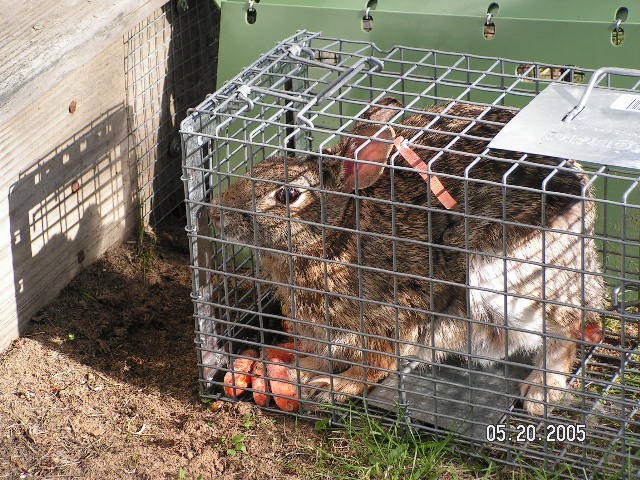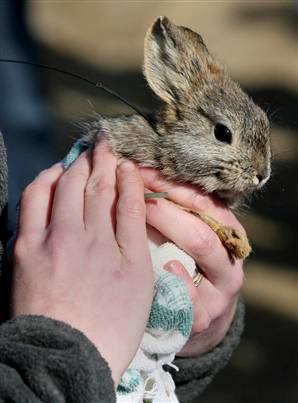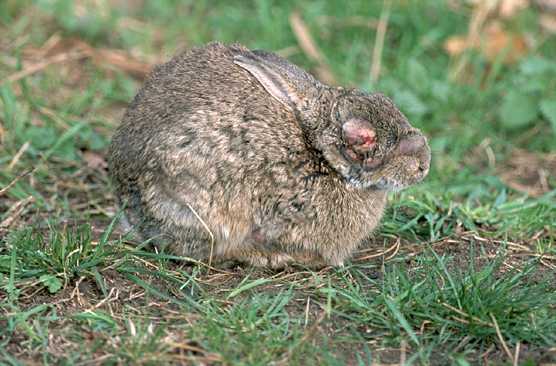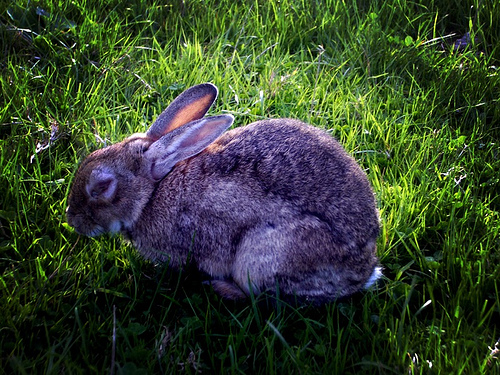Rabbits
Rabbits (Oryctolagus cuniculus)
Originally from north-western Africa, Spain and Portugal but now widespread across much of Europe. Also introduced to many countries and islands, including Australia, New Zealand and Chile. Rabbits were first introduced into Britain by the Normans and they were kept in large, enclosed warrens for their fur and meat. They have gnawing teeth and so used to be classed as rodents, but rabbits and hares have been re-classified into a group of their own, lagomorpha.
Habitat: A wide variety, ranging from farmland to moorlands, woodlands and sand dunes.They generally have greyish-brown fur with orange at nape of neck (black rabbits are fairly common). Long ears (up to 7cm) but shorter than hares' and no black tips. Short tail, black on top and white underneath. The male (buck) 48cm (19in) long. Female (doe) smaller with narrower head.There Life-span is about 9 years. In the wild most rabbits live less than one year.They eat mainly grasses, clovers and other green plants; also bark of trees.
Territory; Rabbits are sociable animals and live in colonies in burrow systems known as warrens. A warren is dug to a depth of 3 metres, may cover a large area and has many entrances. The inside is a maze of interconnecting tunnels, living quarters and nesting chambers. Usually there is a dominant doe within the colony and she will fight other does for the best nest site. Dominant bucks run up and down the boundary lines of their territories, marking as they go; they may do this by depositing droppings on top of an anthill, scratching out shallow scrapes in the ground, or rubbing the ground with the chin to mark the place with scent from glands. Dominant rabbits are the most successful at breeding. Rabbits are mainly nocturnal, emerging from their burrows at dawn and dusk, although on warm, sunny days, or in undisturbed places, they may be out during broad daylight. Feeding takes place close to the warren, so the vegetation around it is kept short by grazing. The rabbit, having many enemies, is always on the alert for danger. If a rabbit spots danger, it will warn others by thumping with a hind foot. A flash of white from under its tail as it runs for a burrow also acts as an alarm signal. The rabbit's prominent eyes are set so that it can see over a wide area. Most of the day is spent underground, resting and passing soft, almost black droppings; these they then eat so that more nourishment can be extracted from them. The rabbits then produce hard, pellet-like droppings above ground, usually in a special 'latrine'. Man is the rabbit's main enemy since it has been regarded as a major pest for the last 200 years. Rabbits cause a lot of damage to crops, gardens and the countryside. Earlier this century when the rabbit population was much larger, they caused such extensive damage to crops and trees that they were included in the Pests Act 1954.
In 1954, a flea-carried virus called myxomatosis was introduced to the wild rabbit population and this killed more than 95% of Britain's rabbits. Myxomatosis is a distressing disease, affecting the eyes and brain. The drastic reduction in rabbit numbers also caused a decline in the number of foxes, buzzards and other predators as well as affecting the growth of vegetation; unwanted plants such as gorse, bramble and coarse grasses were encouraged to grow. However, rabbits are once again more common, having developed a resistance to the virus, although populations in some areas are occasionally affected by new strains of the virus.
Control - The control method depends on the size of the problem. A free onsite visit is usually required to determine the best method. ie. proofing, trapping, shooting, ferreting and long netting etc.
Humane trapping method






